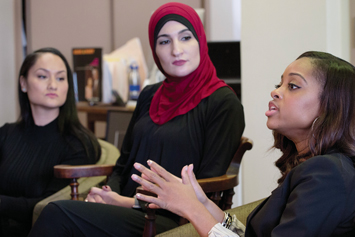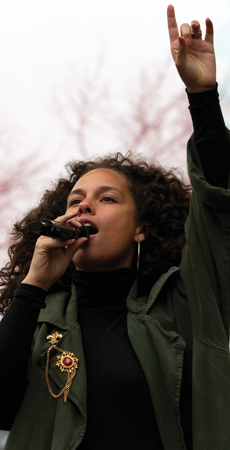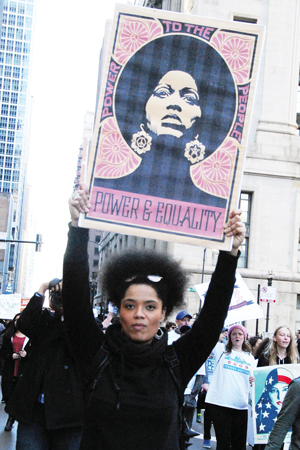and Bryan Crawford The Final Call

WASHINGTON–Controversies leading up to the Women’s March on Washington–ranging from the initial name of Million Women March to the name change to whether Black and Brown women were welcome to whether White women were welcome–didn’t quell a sea of pink when women gathered in numbers that far exceeded expectations.

Not only were the numbers on the National Mall surprising, but numbers from some 600 sister marches in different countries and cities, like London, Paris, Berlin, Tokyo, even Antarctica exceeded expectations. Organizers estimate more than four million people participated worldwide.
“No hatred, no fear! Everyone is welcome here,” chanted women and men Jan. 21 after traveling from near and far and filling D.C. streets.
“Today is an act of resistance,” said Tamika Mallory, a co-organizer of the march and activist with the Gathering for Justice. “Some of you came here to protest one man. I didn’t come here for that. I came here to address those of you who say you are of good consciousness, to those of you who feel a sense of powerlessness, antagonized, threatened and abused. To those of you who for the first time felt the pain that my people have felt since they were brought here in chains shackled to our legs, today we say to you welcome to our world. Welcome to our world.”
“I stand here as a Black woman, descendant of slaves. My ancestors literally nursed our slave masters. Through the blood and tears of my people we built this country. America cannot be great without you, me and all of us here today,” she said.
The march later announced its 10 Actions in the first 100 Days campaign that aims to connect with, organize and “get our friends, family and community together and make history.” Organizers say every 10 days there will be an action related to an issue they care about.

It includes writing postcards to senators about issues march participants and supporters see as important. “Pour your heart out on any issue that you care about, whether it’s ending gender-based violence, reproductive rights and women’s health, LGBTQIA rights, worker’s rights, civil rights, immigrant rights, religious freedom, environmental justice or anything else,” said instructions on the march website. Photos of the post card should be posted to social media with the #WhyIMarch tag, they advised.
“If they won’t let us dream, we won’t let them speak,” added march co-organizer Carmen Perez of the New York-based Justice League and Gathering for Justice to the overwhelming crowd. “We are the ones we have been waiting for.”
Women’s March speakers were activists and celebrities, including women and men, Congressional Black Caucus members, stars Whoopi Goldberg, Cher, Madonna, Ashley Judd, Scarlett Johansson, Alicia Keys and movie maker Michael Moore. Many rejected performing or attending the presidential inauguration the previous day.
‘A country anchored in slavery, colonialism’
“We recognize that we are collective agents of history and that history cannot be deleted like web pages. We know that we gather this afternoon on indigenous land and we follow the lead of the first peoples who despite massive genocidal violence have never relinquished the struggle for land, water, culture, their people. We especially salute today the Standing Rock Sioux,” said author, lecturer and activist Angela Davis.

“The freedom struggles of Black people that have shaped the very nature of this country’s history cannot be deleted with the sweep of a hand. We cannot be made to forget that Black lives do matter. This is a country anchored in slavery and colonialism, which means for better or for worse the very history of the United States is a history of immigration and enslavement. Spreading xenophobia, hurling accusations of murder and rape and building walls will not erase history.”
The Women’s March was dogged by questions about racism, power, White privilege and cultural appropriation from the beginning. What started as a White feminist protest over presidential election results using the name “Million Women’s March” quickly lit up on social media. Organizers dropped that name after Black women balked at the use of a name of a major gathering of Black women some 20 years ago. There were also questions about leadership, issues and inclusion. The name was changed to the Women’s March on Washington, and Black, Muslim and Latino women got involved in top leadership. That leadership included three prominent activists, a Black woman, a Muslim and Palestinian, and a Latina–Tamika Mallory, board member of the Gathering for Justice, a nonprofit founded by Harry Belafonte; Linda Sarsour, executive director of the Arab American Association of New York; and Carmen Perez, executive director of the Gathering for Justice.
The day was a generational experience for many families who came with grandparents, daughters and grandchildren. May Collins from Newark, N.J. said, “I protested in the 60’s and that got us somewhere. My daughter didn’t protest, she went to college and that took us a little farther. Now my granddaughter has to have Trump as her president for the next four years after having the wonderful Obamas. I couldn’t sit home and do nothing,” she told The Final Call.
“I told them we are going to D.C. and march with the women. We can’t sit back and let our country go to hell. We have to do something even if we just carry signs and march with the other women. We are going to do something.”


Very visible in the crowd were Muslim women who also came from around the country to protest, some coming as early as dawn prayer time from Dar Hijrah Masjid in Virginia with a long sign carried by several young women. The sign read, “Respect our Existence or Expect our Resistance.”
Don’t get mad, get organized
The day’s program included an array of Muslim women speakers who ranged from march co-organizer Linda Sarsour to a performance of “Who Ready,” by hip hop artist Alia Sharieff, words from Zahra Biloo of the Council on American Islamic Relations, Ieasha Prime, executive director of Barakah, Inc., who also spoke at the 20th anniversary of the Million Man March in 2015, and Maryum Ali, the eldest daughter of Muhammad Ali.
“Don’t get frustrated, get involved. Don’t complain, organize,” Ms. Ali said. She told The Final Call, “This march is letting the new administration know that they will have a tough time passing laws that take away our human rights. So we’re going to organize and obstruct like the Republicans did for the past eight years. It’s also going to be really hard for him to get reelected with this kind of movement. But the key is we have to get to work.”
Within a short time activist Sarsour was under attack from the right wing on Twitter with varied accusations and anti-Islamic slurs aimed at her. By Jan. 23 #IMarchWithLinda was trending on Twitter as supporters came to her defense in cyberspace.

Hidden Figures star and recording artist Janelle Monae told the crowd, “Continue to embrace the things that make you unique even if it makes others uncomfortable. You are enough. And whenever you’re feeling doubt, whenever you want to give up, you must always remember to choose freedom over fear.”
Millions turn out for march
In Chicago, New York, Los Angeles, Atlanta, St. Paul, Minn., and what were called protests in all 50 states and outside of America, estimates for turn out went as high as four million people across the globe.
Unseasonably pleasant weather helped bring out an estimated 250,000 women, men and children into the streets of Chicago one day after Donald Trump was officially sworn in.
What was planned as a march, eventually turned into a rally, making it the third-largest assemblage of people that day standing up for women, and against Mr. Trump, in the country. There was not enough room for people to actually march safely.
“We must stand up to fear and speak up when we hear prejudices against our brothers and sisters,” said Samantha Marie Ware, a Black cast member of the Chicago production of the Hamilton stage play, who was one of the event’s speakers. “We must and will hold those in power, accountable.”
Many of the protesters carried signs that were demonstrably anti-Trump, but there were also messages promoting women’s rights, support for the Black Lives Matter movement and opposition to this country’s long-standing love affair with guns.
“We are here because we are women. Because we have rights, and we do not agree with this administration’s perspective on guns,” said Cleo Pendleton to the assembled crowd from the stage. She is the mother of Hadiya Pendleton, the 15-year-old King College Prep student who was killed on January 29, 2013 from a stray bullet, a week after performing at Barack Obama’s second inauguration.
“Are you entitled to the Second Amendment?” Ms. Pendleton asked. “Absolutely. But what about the basic human right to build my family and for my family to survive?”
White women and voting for Whiteness
On the ground, marchers expressed various opinions about Mr. Trump, as well on the women–a large majority of them White–who came out in huge numbers and voted for him, helping him to victory.

“I think that those women might be largely religious and conservative. And I think they might’ve placed that above the interests of their bodies and other women’s bodies,” Crystal Rudds, a teacher of women’s literature and Black feminism at Malcolm X College in Chicago, told The Final Call. “People have the right to their particular beliefs, but I think for me as an educator, I feel a lot more education needs to take place in the classroom because a large percentage of Donald Trump’s voters were college educated women.”
“To me, I think a lot of women voted, not based on their gender, but based on their class and on their race,” said Maya Shackelford, a student at Chicago’s Roosevelt University. “It was a lot of White women who voted for Donald Trump, not like Muslims, minorities or Black women. And most of the time, for White people, their race will trump their gender; it’ll trump their class. It’s like they decided they weren’t going to give up their Whiteness, so they voted for the person who was going to keep their Whiteness intact–meaning their class, their ability to move up within that class and have certain privileges that only White people benefit from, which is ridiculous because if you listened to him, Donald Trump does not care about women, the things we go through, or our rights.”
“I’m a huge believer in intersectionality, meaning no one human experience affects one person. So, I’m not just a woman, I’m a Black woman,” added Zeina Thyrus, a DePaul University student. “There’s women from all different types of races, ethnicities and sexual orientations, and there is a combination of things that affect us. So I think it’s important to elect people who are here for all of us, not just some of us, and well-rounded enough to represent all of the realities that American people live as a whole.”
The idea of women, particularly White woman, who helped elect Donald Trump and essentially voted against their own interests, was one shared by many people participating in the march. Not only was deep regret expressed, but it was also considered to be one of the reasons for the deep, multilayered divide that continues to permeate throughout America and in many ways, has already and will continue to grow under his presidency.
Bryan Crawford reported on the Women’s March from Chicago.












